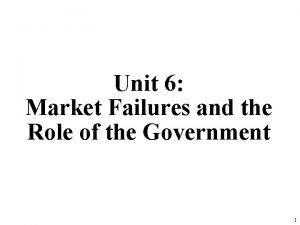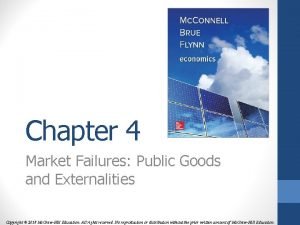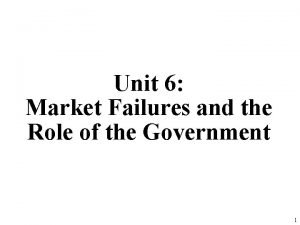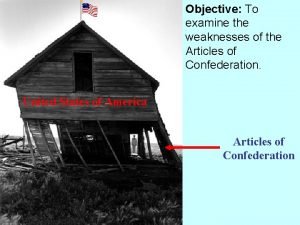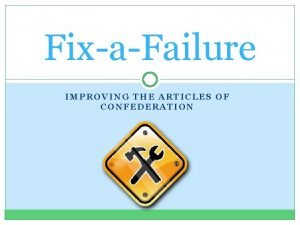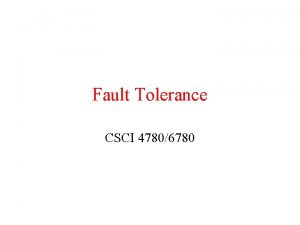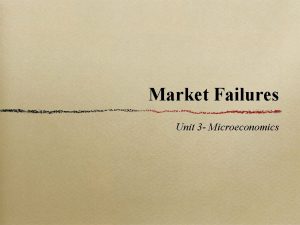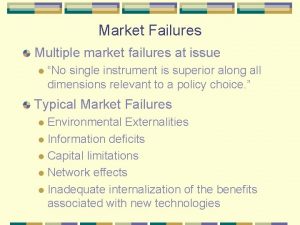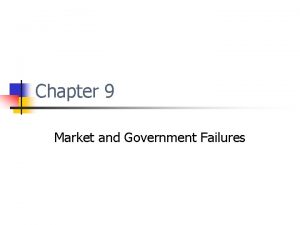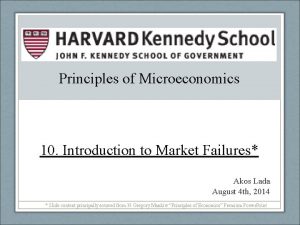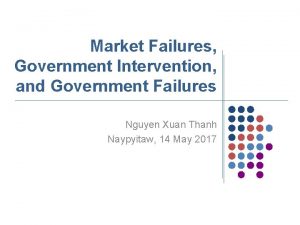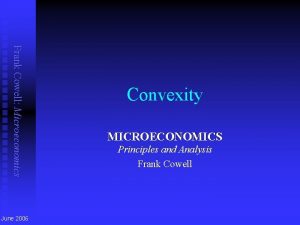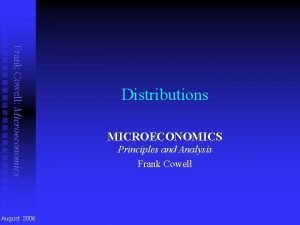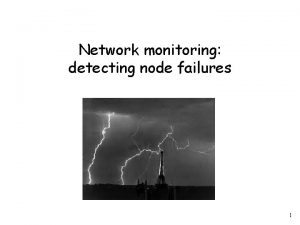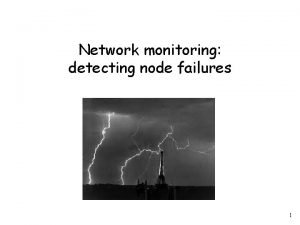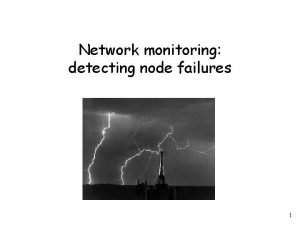Principles of Microeconomics Lecture 15 Market failures University






















- Slides: 22

Principles of Microeconomics Lecture 15: Market failures University of Papua New Guinea

Lecture 15: Market failures Michael Cornish Overview • Introduction • Externalities • Asymmetric information • Low-equilibrium traps Slide 1 The University of Papua New Guinea

Lecture 15: Market failures Michael Cornish Introduction • What is market failure? • Why is it important to address? • Efficiency and equity (again!) Slide 2 The University of Papua New Guinea

Lecture 15: Market failures Michael Cornish Introduction • A typology to identify products where government intervention may be needed: • Rivalrous: where the consumption of the product by one consumer prevents its consumption by another consumer • Excludable: non-paying consumers can be excluded from consuming the product Slide 3 The University of Papua New Guinea

Lecture 15: Market failures Excludable Rival Private goods Examples: • Hamburgers • Clothes Quasi-public goods Examples: Non-rival • Cable TV • Fire-fighting Michael Cornish Non-excludable Common resources Examples: • Tuna in the ocean • Public parks Public goods Examples: • National defence • Street lighting Are more likely to be subject to market failures Tragedy of the commons: Where (rational) self-interest leads to the depletion of common resources - Solved through cooperation, coupled with enforcement! Slide 4 The University of Papua New Guinea

Lecture 15: Market failures Michael Cornish Externalities • An externality is a benefit or cost created by a market that is borne by people outside of the market – I. e. , a benefit or cost external to the market • We can categorise these externalities as: – Positive or negative; – Production or consumption Slide 5 The University of Papua New Guinea

Lecture 15: Market failures Michael Cornish Externalities Negative externalities: • Production: – Classic example? Pollution • Consumption: – Classic example? Passive-smoking • How should we address negative externalities? – One approach: (Pigouvian) taxes! Slide 6 The University of Papua New Guinea

Lecture 15: Market failures Michael Cornish Negative production externality Price of electricity Efficient equilibriu m Deadwei ght loss S 1 = Social cost S 0 = Private cost Cost of pollution PEFFICIENT PMARKET Market equilibrium 0 Slide 7 QEFFICIENT QMARKET Dema ndof electricity Quantity The University of Papua New Guinea

Lecture 15: Market failures Michael Cornish Dealing with a negative production externality Price of electricity Price paid by consumers PEFFICIENT Market equilibriu m with tax PMARKET Price received by producer s Slide 8 0 S 2 = Social cost and private cost tax S after = Private 1 cost before tax Cost of pollution = amount of tax imposed by government Market equilibrium without tax QEFFICIENT QMARKET Deman d Quantity of electricity The University of Papua New Guinea

Lecture 15: Market failures Michael Cornish Externalities Positive externalities: • Production: – Classic example? Bee-keeping and crop pollination – There are not many great examples! • Consumption – Classic examples? Education, immunisation • How should we address positive externalities? – One approach: (Pigouvian) subsidies! Slide 9 The University of Papua New Guinea

Lecture 15: Market failures Michael Cornish Positive consumption externality Price of a university education Positive externality Deadweig ht loss Efficient equilibrium PEFFICIENT PMARKET Market equilibriu m 0 Slide 10 Suppl y QMARKET QEFFICIENT D 1 = Social D 0 = benefit Private benefit Quantity of university education The University of Papua New Guinea

Lecture 15: Market failures Michael Cornish Dealing with a positive consumption externality Price of university education Price received by producers PEFFICIENT PMARKET Price paid by consumer s 0 Slide 11 Positive externality = amount of subsidy Suppl y Market equilibrium with subsidy = efficient equilibrium D 2 = social benefit and private benefit after subsidy D 1 = private benefit before subsidy Market equilibriu m without subsidy QMARKET QEFFICIENT Quantity of university education The University of Papua New Guinea

Lecture 15: Market failures Michael Cornish Externalities Another approach: The Coase Theorem • Private bargaining will result in an efficient solution to the problem of externalities, as long as: – There is perfect information (‘full information’) – Transactions costs are sufficiently low – There are property rights Slide 12 The University of Papua New Guinea

Lecture 15: Market failures Michael Cornish Externalities The Coase Theorem (cont. ) • E. g. , a company creating pollution could pay the victims for the right to pollute; or • The victims could pay the polluting company to reduce its pollution Slide 13 The University of Papua New Guinea

Lecture 15: Market failures Michael Cornish Externalities Yet another approach: Market-based solutions • Tradeable rights markets – Cap-and-trade (e. g. greenhouse gases) – Entitlements (e. g. Murray River water markets) And (another!) approach: Central planning • Also known as ‘command control’ – Use of quantitative controls Slide 14 The University of Papua New Guinea

Lecture 15: Market failures Michael Cornish Asymmetric information • Where a party to a transaction has a different level of information than the other (‘information gaps’) – E. g. the second-hand car market, university education – Leads to inefficient distortions in the market Slide 15 The University of Papua New Guinea

Lecture 15: Market failures Michael Cornish Asymmetric information • Adverse selection is where a party takes advantage of this asymmetric information – Leads to even more inefficient distortions in the market! Slide 16 The University of Papua New Guinea

Lecture 15: Market failures Michael Cornish Asymmetric information can also lead to… • Moral hazard: – Where one person takes more risks because they know that the burden of those risks is borne by another party – E. g. subprime mortgage crisis (the GFC!) Slide 17 The University of Papua New Guinea

Lecture 15: Market failures Michael Cornish Asymmetric information can also lead to… • Principal-agent problem: – Where an agent’s self-interest conflicts with that of their client – E. g. real estate agents Slide 18 The University of Papua New Guinea

Lecture 15: Market failures Michael Cornish Low-equilibrium traps • Occurs where decisions by multiple parties are required simultaneously in order to achieve a more desirable outcome – E. g. creating a manufacturing sector in a poor developing country where none currently exists • Instead, economic decision-makers (such as major investors) remain inactive until all the conditions for them to invest are fulfilled Slide 19 The University of Papua New Guinea

Lecture 15: Market failures Michael Cornish Multiple Equilibria Lowequilibrium trap Slide 20 The University of Papua New Guinea

Lecture 15: Market failures Michael Cornish Case Study: Latin American Time Slide 21 The University of Papua New Guinea
 Intermediate microeconomics lecture notes
Intermediate microeconomics lecture notes Guided reading chapter 7 section 1
Guided reading chapter 7 section 1 Unit 6 market failures and the role of the government
Unit 6 market failures and the role of the government Define market failures
Define market failures Supply-side market failures occur when:
Supply-side market failures occur when: Unit 6: market failures and the role of the government
Unit 6: market failures and the role of the government How are market failures different from perfect competition
How are market failures different from perfect competition Market failures
Market failures 22 rents
22 rents 01:640:244 lecture notes - lecture 15: plat, idah, farad
01:640:244 lecture notes - lecture 15: plat, idah, farad Market leader challenger follower nicher examples
Market leader challenger follower nicher examples International marketing segmentation
International marketing segmentation Articles of confederation fail
Articles of confederation fail Engineering ethics failures
Engineering ethics failures Pitot static failures
Pitot static failures Articles of confederation fail
Articles of confederation fail How did the constitution fix the articles of confederation
How did the constitution fix the articles of confederation Rpc semantics in the presence of failures
Rpc semantics in the presence of failures Aneroid wafer
Aneroid wafer Cloud security failures
Cloud security failures Kublai khan failures
Kublai khan failures Puffery advertising examples in india
Puffery advertising examples in india Fixing service failures
Fixing service failures


